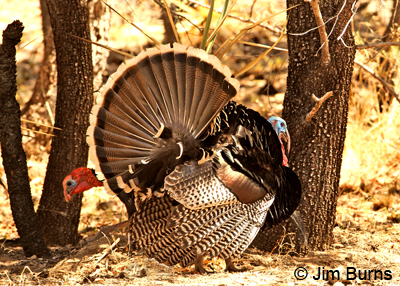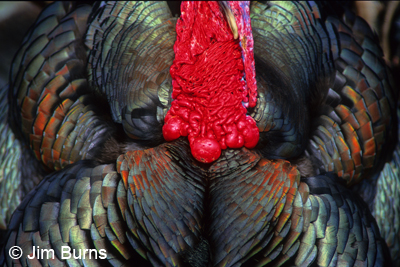
Although I wrote a Thanksgiving specific column two years ago (jimburnsphotos.com/pages/12-2-10.html), it’s never been my intention to do so with any annual regularity. Nonetheless, in talking recently with a novice birder who gushed about her first Wild Turkey sighting, I was reminded of two things: although almost everyone eats turkey on Thanksgiving Day (and many days thereafter), few people ever eat or see a Wild Turkey or even realize that such a creature still exists out there in the wild; and that creature is a beautiful, adaptable, elusive part of our country’s avifauna.
So, here’s a quick primer on Wild Turkey and a few highlights from my personal sightings over the years. The Wild Turkey is endemic to North America. It was thought to be the second most populous vertebrate, after deer, in pre-Columbian times, hunted by eastern Native Americans, but domesticated by western tribes. Hunting and habitat loss in the nineteenth and early twentieth century caused numbers to plummet, but subsequent trap and transplant projects elevated the species to its present population of approximately four million birds, now resident in every lower-forty-eight state.
Without ever looking specifically, I’ve recorded Wild Turkeys in fifteen of those forty-eight, primarily by just spending a lot of time birding and hiking in mature open forests with a variety of tree species. Favored Arizona habitat is pinyon/juniper with adjoining pine/oak. Easiest place to see Wild Turkey in Arizona: at sunup or sundown in warm weather drive backroads in the White Mountains and watch the meadows. Closest place to the Valley, guaranteed: Madera Canyon, flock of 16 with two Toms this past spring. Closest place to the Valley seen but not expected: two hens at Boyce Thompson for several weeks last year. One little realized fact: turkeys roost in trees. One little known fact: turkeys can swim.
FIRST SIGHTING—11/27/70—Cuchara, Colorado
Regular readers of my column know that although I’m not a hunter, I’m not anti-hunting. My lifer Wild Turkey came on a deer hunting trip with two of my best friends. They had the guns, I had my camera to record the whole thing. At dusk, as we walked through wet snow from a tree blind to our campsite, a turkey ghosted across the road in front of us. First sightings are always special, but since it was a Thanksgiving trip we thought this was particularly so. That is until we never saw a deer and burned our tent down trying to stay warm. Maybe this trip was why I never got into hunting.
MOST MEMORABLE SIGHTING—11/27/86—Bright Angel Campground, bottom of the Grand Canyon, Arizona
Another Thanksgiving hiking/camping trip, this turkey was a lone hen named “Kathy” by park rangers. She panhandled through our campsite as we ate dinner, then went to roost over our tent every night. Leaving on Sunday, we hiked up into a snowstorm, breaking trail up to our knees until a pack train passed us.
MOST REWARDING SIGHTING—6/11/89—Thomas Weirs, White Mountains, Arizona.
On a field trip I was leading for Maricopa Audubon Society, a hen and fifteen chicks, called poults, exploded into the trees from beside the trail. We saw Red-faced Warbler and Bald Eagle, but participants voted Wild Turkey best bird of the trip.
MOST ANNOYING SIGHTING—11/30/91—Bosque Del Apache National Wildlife Refuge, New Mexico.
Yet another Thanksgiving trip and another turkey flock with seventeen birds, but this time I was changing a flat tire, filthy dirty, and couldn’t get to the camera. Just as well, perhaps, as turkeys make difficult photographic subjects. Like Coyotes they keep moving, rarely stopping, and spook easily if you try to follow them.
